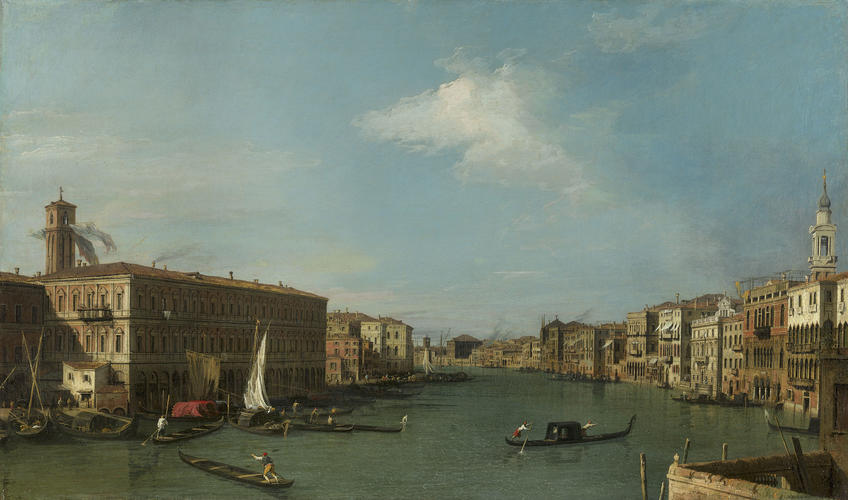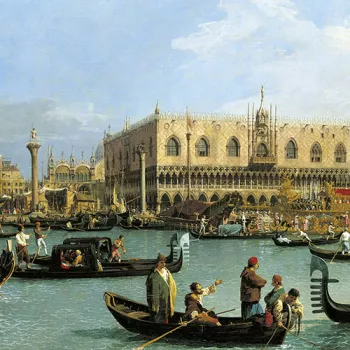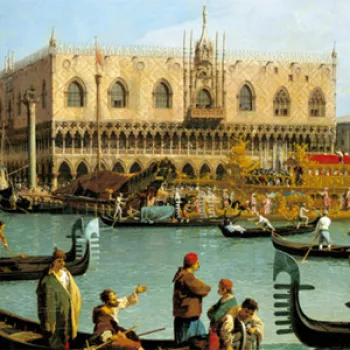The Grand Canal looking North-West from near the Rialto c.1726-7
Oil on canvas | 47.9 x 80.0 cm (support, canvas/panel/stretcher external) | RCIN 406017
-
This is one of a series of twelve views by Canaletto of the Grand Canal which are all the same format. The pictures form the basis of the fourteen engraved plates in Visentini's Prospectus Magni Canalis Venetiarum (Venice, 1735), thus providing an uncontested date for completion. It is thought that they originated in the years around 1730. The paintings were all acquired by George III with the collection of Consul Smith.
The view appears to be taken from somewhere just north of the Rialto bridge, though Canaletto has dramatically widened the vista to include more of both banks of the canal than is visible from a single point. To the left are the extensive Fabbriche Nuove, built to the designs of Sansovino in 1554-6 for the administrators of commerce, as a continuation of the Fabbriche Vecchie of thirty years earlier. Beyond a group of low buildings are the sides of Ca' Corner della Regina, begun in 1724 and here apparently finished (though Canaletto may have 'completed' the building in the painting), and Longhena's Ca' Pesaro.
Along the right bank run a chain of palaces. At far right is the gothic Palazzo Dolfin, followed by the ochre Ca' da Mosto, in Canaletto's day the most famous hotel in Venice (as the Albergo del Leon Bianco). The lower two storeys date from the twelfth or thirteenth century, though the building was remodelled many times, and it appears from the scaffolding on the roof that the fourth floor may have been in the course of construction when Canaletto made his painting.
Two buildings further along is Palazzo Mangilli-Valmarana, the residence of Joseph Smith. After renting the palace for many years, Smith was finally able to purchase it from the Balbi family in 1740, and he commissioned Visentini to renovate and redesign the structure, adding a Palladian façade. After work was completed in 1751, Smith evidently asked Canaletto (presumably on his return from London in 1755) to repaint this detail of the painting, and the thicker paint with deep incisions is clearly visible. The original form of the palace is seen in Visentini's engraving of the painting, which was not reworked for the 1751 edition of the Prospectus.
In the distance is Palazzo Vendramin-Calergi and the belltower of San Marcuola, demolished in the rebuilding of the ancient church in 1728-36. At far left is the belltower of San Cassiano, and at far right that of Santi Apostoli; in fact neither should be visible, each being further to the left and right respectively. Joseph Smith's only child, his son John (1721-c.1727), was buried in Santi Apostoli, where his commemorative tablet may still be seen. (Smith himself was buried in the Protestant cemetery on the Lido, with a commemorative slab in the English church of San Giorgio.)
Catalogue entry adapted from Canaletto in Venice, London, 2005.Provenance
Acquired in 1762 by George III from Joseph Smith, British Consul in Venice (Italian List nos 65-76); recorded in the Gallery at Kew in 1805 (no 8)
-
Medium and techniques
Oil on canvas
Measurements
47.9 x 80.0 cm (support, canvas/panel/stretcher external)
67.8 x 99.9 x 12.0 cm (frame, external)
Category
Object type(s)
Other number(s)
Alternative title(s)
The Grand Canal Looking North from the Rialto










